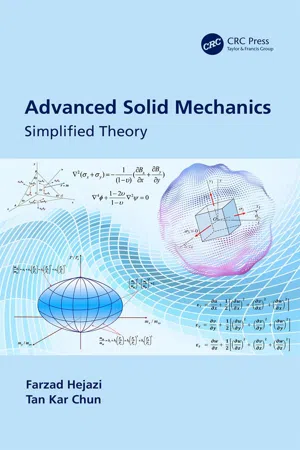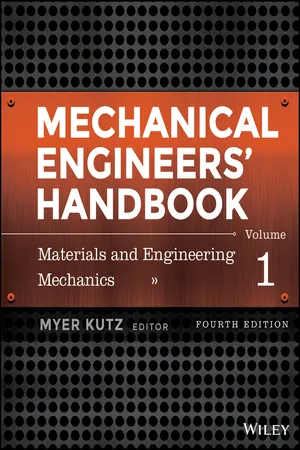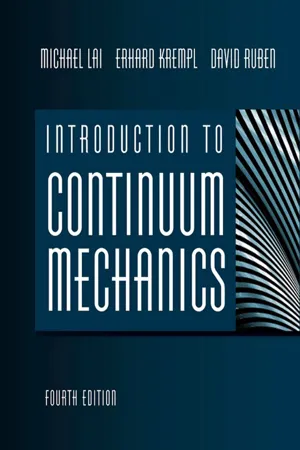Physics
Stress Components
In physics, stress components refer to the forces acting on a material that cause deformation. These forces are typically broken down into normal and shear components, with the normal stress acting perpendicular to the surface and the shear stress acting parallel to the surface. Understanding stress components is crucial for analyzing the behavior of materials under different loading conditions.
Written by Perlego with AI-assistance
Related key terms
Related key terms
1 of 4
Related key terms
1 of 3
8 Key excerpts on "Stress Components"
- eBook - ePub
Elasticity
Tensor, Dyadic, and Engineering Approaches
- Pei Chi Chou, Nicholas J. Pagano, Nicholas J. Pagano(Authors)
- 2013(Publication Date)
- Dover Publications(Publisher)
rθ , as well as a sign to indicate the direction of a particular component. However, when the plane under consideration is understood, we may eliminate one of the indices. The term stress is customarily used quite loosely to represent stress vector, stress component, or stress tensor. The precise meaning of the term is usually clear from the context in which it is used.Fig. 1.2 Force (a Vector) and Stress (Not a Vector)There are two convenient ways which are used to designate the components of a stress vector; the x, y, and z components, and the normal and tangential (shearing) components. The x, y, and z components of an external stress, i.e., the force per unit area acting on the boundary of a body, will be designated as (Fig. 1.3 ). The subscript gives the direction of the component, and the superscript μ defines the plane, i.e., the outward normal of the plane is in the μ direction. For internal stresses on imaginary cutting planes, the x, y, and z components are designated as p x, py , pz . Since these are most frequently utilized as an intermediate step in derivations, and the plane is understood, we use only a subscript.Fig. 1.3 External Stress Vector and Its ComponentsFig. 1.4 Normal and Shearing Stress ComponentsNormal and shearing components of both external and internal stresses are more significant in some problems. We let σ represent the normal stress, i.e., the component of stress perpendicular to the plane on which it acts. The shear stress is denoted by the symbol τ. The latter is the component of stress which lie in the plane. Thus, referring to Fig. 1.4 , where p = dF/dA, we havep 2 = σ 2 + τ 2Let us next consider a three-dimensional state of stress acting on an element as shown in Fig. 1.5 . Body forces are omitted in the figure, since we are merely interested in establishing a nomenclature for stress at this time. In order to develop the terminology necessary to specify a stress component, we must define the plane on which the component acts. Unless otherwise specified, a plane is designated by the direction of its outward normal. In order to determine the direction of the outward normal, we must first establish a free body. The outward normal of any surface, then, points away from the interior of the free body. For example, the right-hand face of the element in Fig. 1.5 is called the x plane, since its outward normal points in the positive x direction. The left-hand face is termed the negative x - eBook - ePub
Advanced Solid Mechanics
Simplified Theory
- Farzad Hejazi, Tan Kar Chun(Authors)
- 2021(Publication Date)
- CRC Press(Publisher)
Fig. 2.3 ).where F is the normal force; A is the area of sectional plane.N o r m a l s t r e s s , σ =(2.1)F AFigure 2.2 Girder subjected to normal force.(2.2)whereV is the shear force;Avis the area of the shear plane.Figure 2.3 Girder subjected to shear force.2.2 Components of stressSolid mechanics studies the stresses and strains at any point on a body, usually illustrated using an infinitesimal cube enveloping the point. Since solids are three dimensional, we can define three mutually orthogonal axes by setting that point as centre. The stress and strain at this point can be categorised based on their direction, with each of them acting along a certain axis. Without other axes to be compared, the defined axes can be assumed not to have any inclination. This will be our reference axes, or global axes, as indicated in Fig. 2.4 .Figure 2.4 Stress Components at a point.Suppose a force is exerted along the x-axis. The developed stress acting along the x-axis is distributed over the plane yz, which is the plane normal to the x-axis. The resultant stress is normal stress along the x-axis, σTable 2.1x. Meanwhile, the stress acting along the y-axis is distributed over the face of the plane yz, which often results in a change in the plane’s shape. The resulting stress is shear stress distributed along the y-axis due to the force acting parallelly on the normal plane of the x-axis, τxy. Similarly, τxzis known as the shear stress distributed along the z-axis due to the force acting parallelly on the normal plane of the x-axis. The notation for strain components can be interpreted in the same way. - eBook - ePub
- James H. Allen(Author)
- 2011(Publication Date)
- For Dummies(Publisher)
Part II Analyzing Stress In this part . . .Stresses are one of the fundamentals of mechanics of materials because they relate internal forces to specific section properties. I start this section by describing the basic categories of stress and then show you how to determine the maximum and minimum values (known as principal stresses) and their orientation angles through several basic transformation techniques. I conclude the part by demonstrating how to calculate stresses for different load types, including axial forces, bending moments, shear forces, and torsional moments.Passage contains an image
Chapter 6 Remain Calm, It’s Only Stress! In This ChapterDefining the basics of stressComputing average stressesGrasping stress’s unitsWorking with stresses at a pointUnderstanding assumptions about plane stress problemsIn the “old days,” engineers used a trial-and-error approach or relied on previous experience. But you don’t really want to build a bridge and load it until it fails just to find out how much it could carry before you broke it. That proposition sounds expensive (not to mention potentially dangerous)! So how do you actually determine whether a particular object made from a particular material can carry a particular load? A more scientific approach involves calculating the actual intensity of the force (known as stress) on an object and then comparing this stress to the intensity of a force that a material is capable of withstanding before it fails. With that information, you can begin predicting the most-critically stressed location in a particular object, which is a fundamental design skill for engineers.In this chapter, I introduce the basic concept of stress because the intensity of a force affects different types of objects in different ways. I start the explanation with the simplest of stress calculations: average stresses. You can then use these average stresses to develop a general relationship about the state of stress at a particular point. Finally, I introduce the concept of plane stress, which is a significant assumption in the formulation of many of the equations and design relationships in Part III. - eBook - ePub
Mechanical Engineers' Handbook, Volume 1
Materials and Engineering Mechanics
- Myer Kutz, Myer Kutz(Authors)
- 2015(Publication Date)
- Wiley(Publisher)
.- SHEAR STRESS is the internal total stress exerted by the material fibers along the plane mn (Fig. 3 ) to resist the action of the external forces, tending to slide the adjacent parts in opposite directions. For equilibrium conditions to exist, the shear stress at any cross section will be equal and opposite in direction to the external force . If the internal total stress is uniformly distributed over the area, the unit shear stress .
- NORMAL STRESS is the component of the resultant stress that acts normal to the area considered (Fig. 4 ).
- AXIAL STRESS is a special case of normal stress and may be either tensile or compressive. It is the stress existing in a straight homogeneous bar when the resultant of the applied loads coincides with the axis of the bar.
- SIMPLE STRESS exists when tension, compression, or shear is considered to operate singly on a body.
- TOTAL STRAIN on a loaded body is the total elongation produced by the influence of an external load. Thus, in Fig. 4 , the total strain is equal to . It is expressed in units of length, that is, inches, feet, etc.
- UNIT STRAIN, or deformation per unit length, is the total amount of deformation divided by the original length of the body before the load causing the strain was applied. Thus, if the total elongation is in an original gauge length , the unit strain . Unit strains are expressed in inches per inch and feet per foot.
- TENSILE STRAIN is the strain produced in a specimen by tensile stresses, which in turn are caused by external forces.
- COMPRESSIVE STRAIN is the strain produced in a bar by compressive stresses, which in turn are caused by external forces.
- SHEAR STRAIN is a strain produced in a bar by the external shearing forces.
- POISSON'S RATIO is the ratio of lateral unit strain to longitudinal unit strain under the conditions of uniform and uniaxial longitudinal stress within the proportional limit. It serves as a measure of lateral stiffness. Average values of Poisson's ratio for the usual materials of construction are:
Material Steel Wrought iron Cast iron Brass Concrete Poisson's ratio 0.300 0.280 0.270 0.340 0.100 - eBook - ePub
- Patrick O'Connor, Andre Kleyner(Authors)
- 2011(Publication Date)
- Wiley(Publisher)
stress concentration factor . Whilst the total or average stress can usually be determined quite accurately, using methods such as finite element analysis, the maximum stress around a stress raiser, and thus the strength, is often much less certain. Stress concentrations can be reduced by designing to provide adequate radii of curvature on corners of stressed components, ensuring that material surfaces are smooth, and, in the case of cracks in sheet material, by drilling a hole at the tip of the crack to increase the radius.Compressive strength is much more difficult to analyse and predict. It depends upon the mode of failure (usually buckling for most engineering materials and components such as steel or aluminium alloy vehicle panels, struts, and electrical connector pins) and the shape of the component. Compressive fracture can also occur, particularly in brittle materials.Structures that have bending loads applied are subjected to both tensile and compressive stress. The upper part of a loaded cantilevered beam will be in tension, whilst the lower part will be in compression.Stress can also be applied in shear . A common practical example is solder joints that connect surface-mounted electronic components (integrated circuit packages) to circuit boards: during operation the temperature rise in the component causes thermal expansion relative to the circuit board, thus applying shear stresses to the solder joints.The discussion above has presented a very brief overview of the topic. In most cases of applied stress the material behaviour is more complex, since combined effects occur. For example, a component in tensile stress will be caused to be compressed in the directions perpendicular to the tensile stress, so there will be a compressive stress also. Bending loads cause varying tensile and compressive stress from top to bottom of the beam, and therefore shear stress within the beam. Fracture in compression might be caused by shear stresses generated in the material. Finite element analysis (FEA), using modern software, can be used to analyse complex loading situations. However, it is nearly always necessary to test structural components to determine their true strength, especially if the designs are not simple. - eBook - ePub
- W Michael Lai, David Rubin, Erhard Krempl(Authors)
- 2009(Publication Date)
- Butterworth-Heinemann(Publisher)
Eq. (4.2.5) ,Eq. (4.2.3) becomes(4.2.6)But from the law of the action and reaction,(4.2.7)therefore,Eq. (4.2.6) becomes(4.2.8)Now, using Eq. (4.2.4) and Eq. (4.2.8) ,Eq. (4.2.1) becomes(4.2.9)That is, the transformation T , defined by(4.2.10)is a linear transformation. It is called the stress tensor or the Cauchy stress tensor .4.3 COMPONENTS OF STRESS TENSOR
According to Eq. (4.2.10) of the previous section, the stress vectors te ion the three coordinate planes (the e i -planes) are related to the stress tensor T by(4.3.1)By the definition of the components of a tensor [see Eq. (2.7.2) ], we have(4.3.2)Thus,(4.3.3)Since te 1is the stress vector acting on the plane whose outward normal is e 1 , it is clear from the first equation of Eq. (4.3.3) that T 11 is its normal component and T 21 and T 31 are its tangential components. Similarly,T 22 is the normal component on the e 2 -plane and T 12 and T 32 are the tangential components on the same plane, and so on.We note that for each stress component T ij , the second index j indicates the plane on which the stress component acts and the first index indicates the direction of the component; e.g.,T 12 is the stress component in the direction of e 1 acting on the plane whose outward normal is in the direction of e 2 . We also note that the positive normal stresses are also known as tensile stresses , and negative normal stresses are known as compressive stresses. Tangential stresses are also known as shearing stresses . Both T 21 and T 31 are shearing Stress Components acting on the same plane (the e 1 - eBook - ePub
Art Conservation
Mechanical Properties and Testing of Materials
- W. (Bill) Wei(Author)
- 2021(Publication Date)
- Jenny Stanford Publishing(Publisher)
Fig. 2.4 ) or the load on hinges used to mount photographs or prints.Figure 2.3 Shear loading where the force is applied parallel to the load-carrying area.Figure 2.4 Examples of shear forces in a cultural heritage object: shear forces on Velcro® strips caused by the weight of a wall tapestry.As we have seen, the force necessary to break the specimen in Fig. 2.1 depends on the geometry of the object. In order to be able to compare materials properties we need to transform the force into a unit that is independent of geometry. That is the unit which was introduced, stress. As we saw above with respect to Fig. 2.1 , stress is defined mathematically as force, F, divided by the area carrying it, A, that is,(2.4)σ =F Awhere stress is written mathematically with the small Greek letter sigma, σ. The unit of stress is Newton per square millimeter, that is, N/mm2 . Note that one will often see stress given in the literature and on the Internet in units of mega-Pascal (MPa, note the double capital letters). Fortunately, the conversion is simple: 1 MPa = 1 N/mm2 , that is, the two units are synonymous.For shear stresses, the small Greek letter tau, τ, is used instead of σ, that is,(2.5)τ =F Awhere the force is now parallel to the load-carrying surface (see Fig. 2.3 ).The strength of a material is defined as the stress at which it fails, in lay terms, when it breaks. The strength of a material is thus given in terms of the word stress. If one looks for materials’ strengths from a supplier, one will always get information and tables in units of stress, N/mm2 - eBook - ePub
- Robert L. Mott, Joseph A. Untener(Authors)
- 2021(Publication Date)
- CRC Press(Publisher)
2 and the resulting stress would beConverting this to pascals would produceStress =Force Area==15 000 N2500mm 26.0 Nmm 2Stress =×6.0 Nmm 2= 6.0 ×( 1000 )2mm 2m 210 6N/m 2= 6.0 MPaIn summary, the unit of N/mm 2 is identical to the MPa . Stress in SI units can be reported asN/m 2or Pascal or PaN/mm 2or megapascal or MPa1–6 Direct Normal Stress
One of the most fundamental types of stress that exists is normal stress , indicated by the lowercase Greek letter σ (sigma), in which the stress acts perpendicular, or normal, to the cross section of the load-carrying member. If the stress is also uniform across the resisting area, the stress is called a “direct normal stress.” Normal stresses can be either compressive or tensile, defined as follows:-
A compressive stress is one that tends to crush the material of the load -carrying member and to shorten the member itself .
-
A tensile stress is one that tends to stretch the member and pull the material apart .
Normal stress is simply, then, another way of saying tensile or compressive stress. The equation for direct normal stress follows from the basic definition of stress because the applied force is shared equally across the entire cross section of the member carrying the force. That is,
Index pages curate the most relevant extracts from our library of academic textbooks. They’ve been created using an in-house natural language model (NLM), each adding context and meaning to key research topics.
Explore more topic indexes
Explore more topic indexes
1 of 6
Explore more topic indexes
1 of 4







